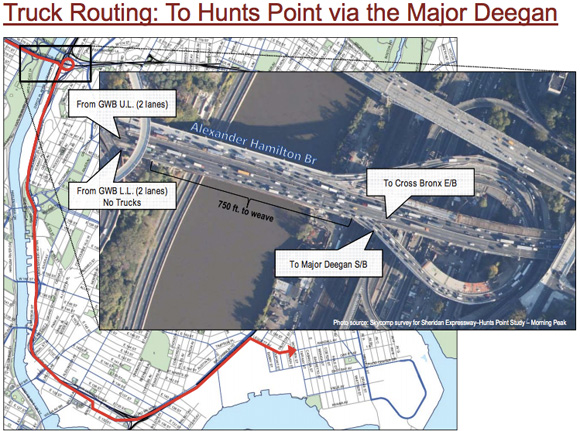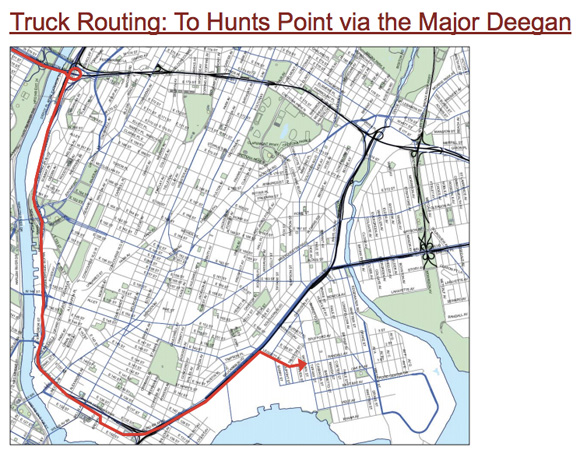You Can Drive a Truck Through the Gaps in City’s Refusal to Remove Sheridan
2:26 PM EDT on June 28, 2012
Last month, the Bloomberg administration unexpectedly ruled out the option of removing the Sheridan Expressway and replacing it with housing and parks, telling South Bronx advocates that added truck traffic projected for local streets was a "fatal flaw" in the highway teardown. After a closer look at that truck traffic analysis, however, the coalition calling for the highway removal says the city overlooked some obvious options to keep trucks off neighborhood streets.
When the city's Sheridan team started meeting with South Bronx community groups last year, they indicated that the teardown decision would take a wide range of factors into account, like economic development and pollution reduction. But at a meeting with advocates on May 10, the city changed course and ruled out removing the highway based only on an analysis of truck traffic. The about-face came while the NYC Economic Development Corporation is negotiating a long-term contract with wholesale distributors at the Hunts Point Produce Market, which some trucks access via the Sheridan. As WNYC reported today, the market was opposed to the teardown, and city officials have indicated privately that the removal plan was a casualty of the negotiations.
Now the South Bronx River Watershed Alliance -- the coalition that supports removing the Sheridan -- is highlighting flaws in the truck traffic analysis and pressing the city to resume a full study of the teardown plan."They have taken the worst-case traffic scenario and used it to justify dropping this alternative from further study,” said Veronica Vanterpool, executive director of the Tri-State Transportation Campaign.
The Sheridan teardown plan includes measures to keep truck traffic off residential streets -- specifically, the construction of new ramps from the Bruckner Expressway to Oak Point Avenue, giving trucks a more direct route to the Hunts Point market. But the city asserted that under the teardown scenario, trucks would not switch from the Sheridan route to the Bruckner route. Here's why advocates say that assumption is off-base.
Currently, trucks accessing the Hunts Point market from the George Washington Bridge can either take the Cross-Bronx Expressway to the Sheridan, or take the Major Deegan to the Bruckner (as identified in this study prepared by STV, Inc. for DOT [PDF]). In the Sheridan teardown scenario, a critical component of the highway system is the Alexander Hamilton Bridge, which carries I-95 across the Harlem River. Trucks have only 750 feet to travel between ramps from the upper level of the George Washington Bridge, which are on the inside of the highway on the west side of the Alexander Hamilton Bridge, to the ramps to the Major Deegan, which are on the outside of the highway on the bridge's east side.
Instead of having truckers perform this merging maneuver in the teardown scenario, DOT told advocates at the May 10 meeting that trucks would continue to use the Cross-Bronx and then exit onto neighborhood streets on the way to Hunts Point. Not surprisingly, the study found that this truck routing would have negative consequences, including low clearances at railroad crossings, a heavy impact on local streets and increased trip time and distance for trucks. So DOT declared that there were “fatal flaws” in the removal option and eliminated it from further consideration.
But DOT failed to mention some straightforward ways to address these flaws, according to advocates who have studied the Sheridan project. For instance, Hunts Point-bound truckers would not have to make a quick merge to get to the Major Deegan if they were allowed to use the lower level of the George Washington Bridge, as was permitted before September 11, 2001. Restore that access, and trucks could more easily take the Deegan to the Bruckner, which would take them straight to the new Hunts Point ramps at Oak Point Avenue. “That conversation has been happening for some years,” said TSTC's Vanterpool about reopening the lower level. “It's not a new request of the Port Authority.”
Another option to mitigate truck traffic on local streets would be to add a ramp from the Cross-Bronx to West Farms Road, a truck route that runs parallel to the Sheridan. Instead, DOT's analysis assumed trucks heading from the Cross Bronx to Hunts Point would have to use other local streets. In two of DOT's routing options, trucks would exit the Cross Bronx more than a mile west of West Farms Road, at Webster Avenue, then follow existing truck routes through Bronx neighborhoods. Another scenario involved creating a new truck route on Bronx River Avenue. If the city factored in a new ramp connecting the Cross-Bronx to West Farms Road, the impact on local streets would not be so great.
Members of the teardown coalition also called the city's traffic modeling unrealistic, and noted the absence of well-defined criteria for rejecting the highway removal. "There's never been a cohesive explanation” of this decision, said Elena Conte of the Pratt Center for Community Development. "DOT did not do any kind of choice model. You always see traffic dissipate to some extent. They used a one-to-one replacement." In addition, Conte explained, "there's not even a definition of what they consider to be a fatal flaw."
Overall, say advocates, what was supposed to be a comprehensive look at options for the Sheridan Expressway has turned into an oversimplified justification to avoid tearing down the highway. According to the city's explanation, the South Bronx can either remove a highway or keep lots of truck traffic off local streets, but not both. “It's absolutely a false choice,” said Conte.
"There's still a lot of unanswered questions about how they've removed this option from the table," Vanterpool said. “We would have liked this to have been a dialogue, as opposed to being presented with, 'We're dropping this option.'"
As the city moves to eliminate the teardown option from further study, other options remain undefined. The two other scenarios for the Sheridan are "modify" and "retain," but the specifics of the "modify" scenario still seem to be up in the air. At the May 10 meeting, city officials described this alternative as the Sheridan being “retained for local and pass-through traffic with some modifications.” It's not yet clear exactly how significant those modifications might be.
The next meeting between project staff and the Community Working Group is scheduled for later today. It looks like the Department of City Planning is ready to move the study forward without the removal option, since the agenda up for discussion is land use, not transportation. But advocates will continue to press for the removal option, and local elected officials including Representative Jose Serrano and City Council Member Maria Del Carmen Arroyo are on their side.
“If there is the political will, funds can be found to move many things forward,” Vanterpool said. “So I don't see this as a done deal.”
Stay in touch
Sign up for our free newsletter
More from Streetsblog New York City
Friday’s Headlines: Canal Street Follies Edition
Manhattan Borough President Mark Levine isn't happy. Plus other news.
Daylight Again: Bronx Community Board Backs Parking Ban at Intersections
The Boogie Down is down with daylighting!
Community Board Wants Protected Bike Lane on Empire Blvd.
Brooklyn Community Board 9 wants city to upgrade Empire Boulevard's frequently blocked bike lane, which serves as a gateway to Prospect Park.
The Brake: Why We Can’t End Violence on Transit With More Police
Are more cops the answer to violence against transit workers, or is it only driving societal tensions that make attacks more frequent?
Report: Road Violence Hits Record in First Quarter of 2024
Sixty people died in the first three months of the year, 50 percent more than the first quarter of 2018, which was the safest opening three months of any Vision Zero year.






